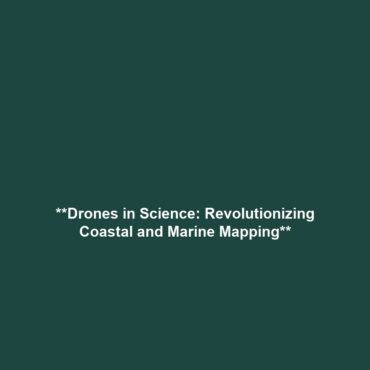Coastal and Marine Mapping: Drones Monitoring Oceans and Coastlines
Introduction
Drones play a pivotal role in the evolving field of Coastal and Marine Mapping, transforming how we monitor oceans and coastlines. These unmanned aerial vehicles (UAVs) offer innovative solutions for capturing high-resolution data about marine environments, critical for managing coastal resources and protecting ecosystems. As a segment of Drones in Science, the application of UAV technology is broad, enhancing research capabilities and data collection methods. This article delves into the significant aspects of drone utilization in marine mapping, exploring its applications, challenges, and future prospects.
Key Concepts
Understanding Coastal and Marine Mapping
Coastal and marine mapping involves the use of technology to capture and analyze data related to bodies of water and surrounding land. Drones provide a unique vantage point for gathering information regarding:
- Bathymetric Mapping: Utilizing drones equipped with LiDAR and sonar to measure underwater depths.
- Coastal Erosion Monitoring: Tracking changes in shoreline position to assess erosion rates.
- Habitat Mapping: Identifying vital habitats like coral reefs and seagrass beds.
These concepts align with the overarching theme of Drones in Science, showcasing how UAV technology enhances scientific understanding and environmental conservation.
Applications and Real-World Uses
The applications of Coastal and Marine Mapping using drones are diverse and impactful. Key practical uses include:
- Environmental Monitoring: Drones are employed to track pollution levels and monitor the health of aquatic ecosystems.
- Search and Rescue Operations: UAVs facilitate quick assessment and data gathering during emergencies.
- Coastal Planning: Aiding local governments in planning and executing coastal development while minimizing environmental impact.
Understanding how Coastal and Marine Mapping is used in Drones in Science reveals the transformative potential of drone technology for enhancing marine stewardship.
Current Challenges
Despite their advantages, several challenges of Coastal and Marine Mapping exist within the context of Drones in Science:
- Regulatory Limitations: UAV operations are subject to stringent regulations which can limit accessibility and frequency of data collection.
- Technical Limitations: Issues with battery life and payload capacity can hinder extended missions.
- Data Processing Challenges: Converting vast amounts of aerial data into useful information can be complex and time-consuming.
Future Research and Innovations
Looking ahead, several innovations promise to further enhance the field of Coastal and Marine Mapping using drones. Key areas of development include:
- Advanced Sensors: Utilizing next-generation sensors for more accurate data collection.
- AI and Machine Learning: Employing AI algorithms for better data analysis and predictive modeling.
- Improved Battery Technology: Extending flight durations to enable comprehensive territorial mapping in single missions.
These advancements signify a promising future for Drones in Science, positioning drones as essential tools for marine research and environmental monitoring.
Conclusion
In summary, Coastal and Marine Mapping using drones is a critical component of modern scientific practices that enhance our understanding of oceans and coastlines. With ongoing advancements and applications, the future is bright for this technological approach. Researchers, environmentalists, and policymakers must continue to collaborate to leverage drones effectively for marine conservation. For further exploration of drone technology and its implications in other scientific areas, consider visiting our related articles on Drones in Agriculture and Drones for Wildlife Monitoring.
